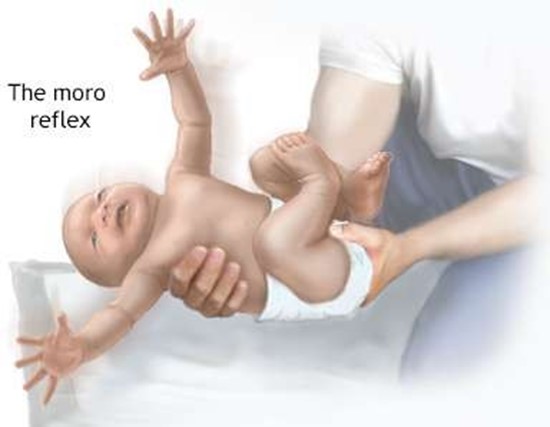A nurse is checking a newborn’s Moro reflex.
Which of the following actions should the nurse take to elicit this reflex?
Place the newborn on their abdomen and observe the movement of their extremities.
Stroke the newborn’s cheek toward their mouth.
Stroke upward on the lateral aspect of the newborn’s foot.
Place the newborn on a flat surface and clap hands loudly.
The Correct Answer is D
Place the newborn on a flat surface and clap hands loudly.

This action will elicit the Moro reflex, also known as the startle reflex, which is a normal, involuntary reaction that newborns and infants have when they’re startled. In response to the sound, the baby will throw back his or her head, extend out his or her arms and legs, cry, then pull the arms and legs back in.
Choice A is wrong because placing the newborn on their abdomen and observing the movement of their extremities will not trigger the Moro reflex.
This position may elicit other reflexes such as the crawling reflex or the tonic neck reflex.
Choice B is wrong because stroking the newborn’s cheek toward their mouth will not trigger the Moro reflex. This action will elicit the rooting reflex, which helps the baby find the breast or bottle to start feeding.
Choice C is wrong because stroking upward on the lateral aspect of the newborn’s foot will not trigger the Moro reflex. This action will elicit the Babinski reflex, which causes the big toe to extend upward and the other toes to fan out.
Nursing Test Bank
Naxlex Comprehensive Predictor Exams
Related Questions
Correct Answer is B
Explanation
“I will not play soccer until my doctor tells me I can.” This statement indicates that the client understands the risk of splenic rupture due to splenomegaly and the need to avoid contact sports until the spleen returns to normal size.
Choice A is wrong because antibiotics are not effective for infectious mononucleosis, which is caused by a virus.
Choice C is wrong because varicella booster is not related to infectious mononucleosis and there is no evidence that the client needs it.
Choice D is wrong because jaundice (yellowing of the eyes and skin) is not a common manifestation of infectious mononucleosis and may indicate another condition such as hepatitis.
Normal ranges for spleen size are 7 to 14 cm in length and 3 to 4 cm in thickness.
Correct Answer is C
Explanation
This is a manifestation of a fat embolism, which is a condition where particles of fat get into the bloodstream and block blood flow. A fat embolism can occur after trauma or surgery to the legs, when fat from the bone marrow escapes into the bloodstream.
Choice A is wrong because a report of pain as 6 on a scale of 0 to 10 is not specific to a fat embolism.
Pain is a common symptom of many conditions and injuries.
Choice B is wrong because pulses 2+ distal to the client’s fracture are normal and indicate adequate blood flow to the extremity.
Choice D is wrong because bruising around the fracture site is an expected finding after a compound fracture and does not indicate a fat embolism.
Normal ranges for blood pressure are 90/60 mmHg to 120/80 mmHg and for heart rate are 60 to 100 beats per minute.
Petechiae are small red or purple spots on the skin caused by bleeding under the skin.
They can range in size from pinpoint to several millimeters. Fat embolism syndrome (FES) is a serious complication of a fat embolism that affects the lungs, skin or brain and can be fatal. FES usually occurs 12 to 72 hours after trauma.
Whether you are a student looking to ace your exams or a practicing nurse seeking to enhance your expertise , our nursing education contents will empower you with the confidence and competence to make a difference in the lives of patients and become a respected leader in the healthcare field.
Visit Naxlex, invest in your future and unlock endless possibilities with our unparalleled nursing education contents today
Report Wrong Answer on the Current Question
Do you disagree with the answer? If yes, what is your expected answer? Explain.
Kindly be descriptive with the issue you are facing.
